
by Paul Schreyer
January 28, 2013
from
GlobalResearch Website
“If a mandarinate ruled America,
the recruiting committee on September 11
would have had to find someone like Cheney.”
Washington Post author Barton Gellman
in his book
“Angler: The Cheney Vice Presidency”
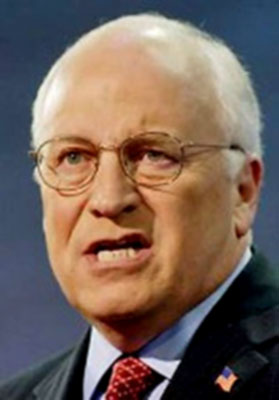
Terrorism. Emergency plans.
Political careers.
The history of 9/11 can be written from
many angles.
But whatever point of view is chosen, Dick Cheney is a
central figure. “Principle is okay up to a certain point”,
he once said, “but principle doesn't do any good if you lose
the nomination”.
He's surely an elusive
character. Not less than Donald Rumsfeld, his close
companion. Both of their lives are inseparably bound with a
dark side of recent American history.
The core of the following story
was originally told by the authors James Mann and Peter Dale
Scott whose thorough research is deeply appreciated. Yet a
lot of background information was added.
Thus a bigger picture slowly
took shape, showing a plan and its actors …
Cheney and Rumsfeld were an old team.
Major parts of their careers they had
spent together. Both had no privileged family background. Cheney's father
worked as an employee for the department of agriculture, Rumsfeld's father
had a job in a real estate company. The families' living conditions were
modest.
Both sons could go to university only with the backing of
scholarships.
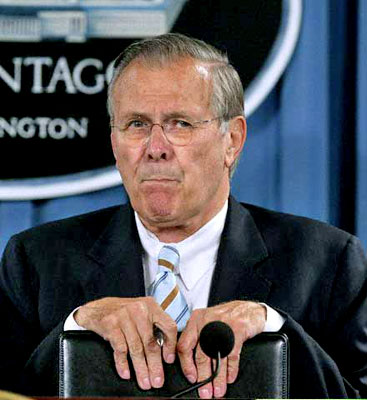
Rumsfeld, born 1932, chose political science. He was a rather small and
sturdy person, but with energetic charisma.
While at university he engaged
in sport and was known as a successful ringer. Later Rumsfeld went to the
Navy to become a pilot. The Navy hat paid a part of his scholarship. At the
end of the 1950s he eventually started his career in politics as assistant
of a congressman.
Meanwhile father of a young family, and following a short
intermezzo at an investment bank, Rumsfeld himself ran for Congress, at the
age of 29 only.
Getting backing
The prospects in his Chicago home district were unfavorable. He was
inexperienced and almost without any voter base, compared to the other
candidates.
But the dynamic and ambitious Rumsfeld impressed some of Chicago's business leaders, such as the boss
of Pharma heavyweight Searle.
They paid for his campaign. With this economic power in his back also one of
Chicago's newspapers supported him.
Rumsfeld won the election in 1962 and
went to Washington as a republican representative.
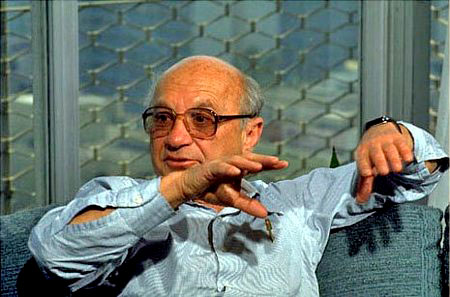
At the beginning of the 1960s he visited lectures at the University of
Chicago, where Milton Friedman was teaching, one of the most influential
economists of his time.
Friedman was one of the founding fathers of neoliberalism. He called for less influence of the state and praised the
self regulation of the markets. In 1962 his bestseller Capitalism and
Freedom was published.
Rumsfeld was impressed by these thoughts.
In a speech
honoring Friedman 40 years later he remembered:
“Government, he has told us,
has three primary functions: It should provide for the military defense of
the nation. It should enforce contracts between individuals. And it should
protect citizens against crimes against themselves or their property.” (1)
This self-imposed restriction of politics was also the core of Rumsfeld's
belief while he served in Congress in the 1960s.
An apprentice in
politics
Cheney, 9 years younger than Rumsfeld, meanwhile studied political science
as well.
First at Yale, where he left soon because of poor grades, then at a
less prestigious university in the Midwest. Contrary to the forceful
Rumsfeld he appeared rather defensive, quiet and cautious. His imminent
recruiting to the Vietnam war he avoided by getting deferred from military
service because of his study at the university and the pregnancy of his
wife, until he couldn't be recruited because of his age in 1967.
At the age of 27 Cheney was looking for a job in Washington. He applied for
an internship at Rumsfeld's office. But Rumsfeld rejected him. The failed
interview was embarrassing for Cheney who in later times liked to tell the
story of this flop as an anecdote.
But soon both men found together.
Under president Nixon, Rumsfeld had switched in 1969 from Congress to
government. First he ran the Office of Economic Opportunity. There he
administered federal social programs - not exactly one of his major
concerns, but still one step forward in career. Rumsfeld was looking for new
staffers to pass on work. By recommendation of a befriended representative
he employed Cheney as his assistant.
Cheney was a diligent worker and
quickly made himself indispensable. Whoever wanted something from Rumsfeld,
learned soon to try it via Cheney.
Rumsfeld's career developed. People started becoming aware of him
nationwide. He looked good, was energetic and had a catching smile. His
intelligence was outstanding. But he also liked to exaggerate and escalate
conflicts and often was unnecessarily blunt to others.
Soon he became
president Nixon's advisor (who would praise him as a “ruthless little
bastard”).
Three years later he went to Europe becoming NATO's ambassador
there - escaping from Washington shortly before the Watergate affair would
kill the careers of many of Nixon's advisors.
Tasting power
In the mid of the 1970s politics in America went through a time of upheaval.
The economy was in crisis. With the lost war in Vietnam, nationwide student
protests and Watergate the leadership of the superpower showed internal
signs of decay, culminating in Nixon's resignation in 1974. Successor Gerald
Ford appointed Rumsfeld to become chief of staff with Cheney shadowing him
closely as his deputy.
Now both men had arrived in the centre of power. The position of chief of
staff was seen as highly influential in the White House. He was the closest
advisor to the president, controlled his schedule and also decided who would
meet him.
After Nixon, Watergate and the extensively publicly discussed CIA
scandals the new administration had to fight with a damaged reputation. This
difficult situation, with a relatively weak president, increased the
importance of the chief of staff.
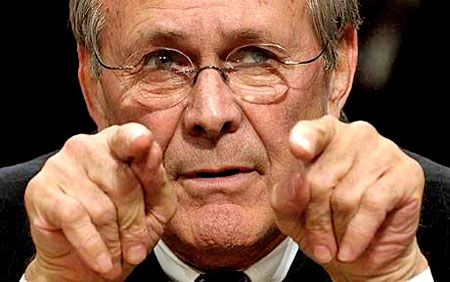
Rumsfeld and Cheney were partners now and had great influence on president
Ford.
When he reshuffled his cabinet abruptly in 1975 in the so-called
“Halloween massacre”, firing among others the CIA director and the secretary
of defense, many suspected Rumsfeld being the wirepuller.
Fact was at least
that he and Cheney were profiteering.
Rumsfeld now took over the command at the Pentagon. There he started
expensive and prolonged defense projects like the Abrams tank and the B-1
bomber, building economic impact for decades. At the same time the 34 years
old Cheney moved up to become chief of staff in the White House.
Now he was
no longer only assistant but an authority with relevant beliefs.
One of his
rules went:
“Principle is okay up to a certain point, but principle doesn't
do any good if you lose the nomination.” (2)
Revolving doors
However soon just that happened.
After the defeat of the Republicans in 1976
both men dropped out of government. Together with their families they spent
holidays with each other in the Caribbean.
Rumsfeld remembers the relaxing
break with pleasure:
“We played Tennis, boated, and spent time in the sun
talking about life. Cheney grilled steaks and made chili.” (3)
Back home Cheney started capitalizing his Washington insider knowledge by
working for a consulting company, helping wealthy clients with their
investment decisions.
But soon he returned to politics.
At the end of the
1970s he went as elected Congressman to the House of Representatives. Yet
the stress and pressure had their effect on the cautious and restrained
Cheney - at age 37 he suffered his first heart attack.
Rumsfeld on the other hand found his new place for a longer time in private
business. Dan Searle, the Chicago Pharma magnate who had financed his first
election campaign 15 years before, now entrusted him his whole company,
appointing him to Searle's CEO. Financially Rumsfeld climbed to new heights
with that job.
As CEO he got 250.000 Dollars a year, about four times more
than as secretary of defense. (4)
And also in his new job he made no half
measures. Within short time Rumsfeld fired more than half of the employees,
generating a huge increase in corporate profit. The business newspapers
praised him as an outstanding manager.
In the 1980s the Republicans came back to power with Ronald Reagan. The new
president conjured up the threatening picture of the Soviet Union as an
“evil empire” and increased military spending.
The Cold War gained new
momentum.
The Armageddon Plan
At this time the White House also developed a secret emergency plan, put in
action however only at September 11th, 2001 for the first time.
Initially it
should guarantee that the government could continue its operations even
after a Soviet nuclear strike. The plan was called
COG (Continuity of
Government) and called for a very special emergency measure: when disaster
struck, three teams should be sent to different places in the country,
replacing the government.
Each team would have an own “president” as well as
other people standing in for the different departments and government
agencies.
If one team would be killed, the next one could be activated. So
the planners hoped to keep control over the military and the most important
parts of the administration, after an atomic bomb or another disaster had
wiped out the government in Washington. (5)
These worries about a possible “decapitation” of the national leadership
were deemed very seriously because exactly this course of action was also
part of the U.S. war strategy towards the Soviets. (6)
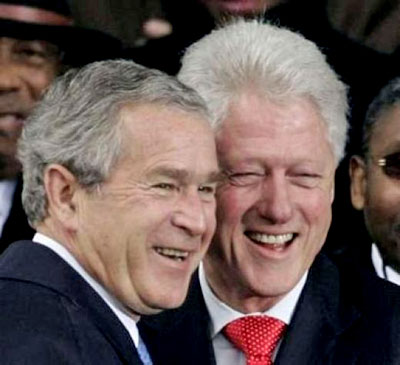
The COG plan existed not only on paper. It was exercised in reality
regularly in the 1980s.
Once a year the teams, each consisting of a
“president”, a “chief of staff” and about 50 staffers, were secretly flown
from Washington to a closed military base or a bunker somewhere in the
United States.
There they played the emergency scenario for several days.
Not even their closest relatives knew about the location or purpose of the
exercise. (7)
Richard Clarke, later anti-terror coordinator under the presidents Clinton
and Bush junior, recalls one of the maneuvers at that time:
”I remember one occasion where we got the call.
We had to go to Andrews Air
Force Base and get on a plane and fly across the country. And then get off
and run into a smaller plane. And that plane flew off into a desert
location. And when the doors opened on the smaller plane, we were in the
middle of a desert.
Trucks eventually came and found us and drove us to a
tent city. You know, this was in the early days of the program. A tent city
in the middle of the desert - I had no idea where we were. I didn’t know
what state we were in. We spent a week there in tents, pretending that the
United States government had been blown up. And we were it.
It’s as though
you were living in a play. You play-act. Everyone there play-acts that it’s
really happened. You can’t go outside because of the radioactivity. You
can’t use the phones because they’re not connected to anything.” (8)
Part of every team was one authentic secretary, leading a government
department also in real life.
He had to play the president. Yet his real
life portfolio didn't matter - at one point even the secretary of
agriculture played the president. In the end the secretary taking part in
the exercise was usually just the one being dispensable. Apparently more
important was the role of the chief of staff.
This part was routinely played
only by a person who had been White House chief of staff also in real life.
(9)
Therefore Rumsfeld and Cheney were regular participants of the secret annual
COG exercises. Other attendants described them as being involved in shaping
the program. (10)
So at a time when the two men had no position whatsoever
in government (Rumsfeld, as mentioned, was boss of a Pharma company, Cheney
was congressman), both of them disappeared every year for a few days to
practice the take-over of the government after a disaster.
Above the law
The plan was secret also because it bypassed the constitution.
Since the
presidential succession was already explicitly fixed by law:
if the
president died, the vice president took over, then followed by the speaker
of the house, after him the longest serving senator, then the secretaries of
state, treasury, defense and so forth.
However the COG plan simply ignored
this well balanced constitutional arrangement. In an emergency it called
instead for a president who was not democratically legitimized at all.
The plan was authorized with a secret directive by president Reagan.
According to his security adviser Robert McFarlane, Reagan personally decided
who would lead the individual teams. The COG liaison officer in charge
inside the National Security Council was Oliver North, who later became
known as the key person in the center of the
Iran-Contra scandal. (11)
Only incidentally, in connection with that scandal, the first details of the
secret plan came to light in 1987. Under president Reagan Lieutenant Colonel
Oliver North had coordinated a series of steps building in effect a shadow
government, Congress didn't know about, let alone having approved it.
The
Miami Herald wrote about this in 1987:
“Oliver North helped draw up a
controversial plan to suspend the Constitution in the event of a national
crisis, such as nuclear war, violent and widespread internal dissent or
national opposition to a U.S. military invasion abroad. (…)
From 1982 to
1984, North assisted FEMA, the U.S. government’s chief national
crisis-management unit, in revising contingency plans for dealing with
nuclear war, insurrection or massive military mobilization.” (12)
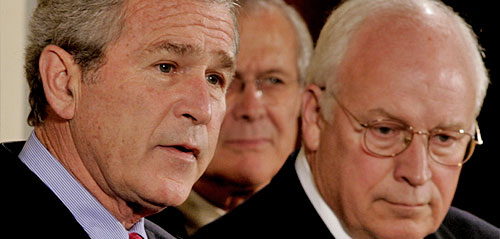
That the COG plan, suspending the constitution, could indeed not only be
activated in case of a nuclear war, was laid out in a further directive
authorized by Reagan in the last days of his presidency in November 1988.
According to this directive the plan should be executed in a “national
security emergency”, defined rather vague as a “natural disaster, military
attack, technological emergency, or other emergency, that seriously degrades
or seriously threatens the national security of the United States”. (13) In
effect this meant a massive undermining of democratic principles.
The COG
plan, executed under the circumstances mentioned, could also be used as
cover for a coup d’état.
Meanwhile Cheney and Rumsfeld went on secretly exercising the take-over of
the government during their annually running maneuvers. Belonging to this
inner circle of potential state leaders had to be an uplifting feeling for
both men. In case of a huge disaster the fate of the nation would lie in
their hands.
Reach for the
presidency
At the end of the 1980s Cheney moreover had climbed to the board of the
Council on Foreign Relations,
the elite network connecting business leaders
and politicians, well known for its huge influence on American foreign
policy.
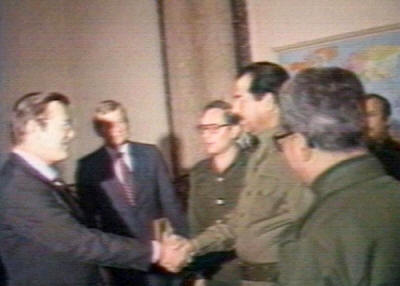
In the meantime Rumsfeld had become a multimillionaire through the
sale of the Pharma company he had led.
He planned running for the presidency
in 1988. But his campaign didn't succeed.
From the outset Reagan's vice
president Bush senior had been the republican frontrunner - and finally also
won the election.
But now Cheney got his chance. He became secretary of defense in the new
administration, the same position Rumsfeld had already held 12 years before.
Cheney successfully managed the first Iraq war in 1991, which led - parallel
to the decline of the Soviet Union - to a permanent deployment of U.S.
troops in the oil-rich Saudi Arabia.
The control over Iraq was now in reach.
After the defeat of the Republicans in 1992 Cheney also considered an own
presidential campaign. Yet soon he had to realize that he lacked support.
Instead he moved to the private sector, becoming CEO of Halliburton, one of
the world's biggest oil supply companies. As secretary of defense he already
had build connections to the firm, leading later to multi-billion-dollar
contracts with the Pentagon.
The new job now also filled Cheney's pockets,
making him a multimillionaire as well.
Meanwhile Rumsfeld had established himself as a highly effective and
ambitious business executive. In the 1990s he first led a telecommunications
company, then a pharma corporation.
The COG plan still existed, however with other presumptions. After the fall
of the Soviet Union it no longer focused on the Russian nuclear threat, but
on terrorism. Though it was reported in the mid 1990s that president Clinton
wanted the program to phase out, it later became clear that this
announcement only applied to the portion of the plan relating to a nuclear
attack. (14)
Then anti-terror coordinator Richard Clarke later disclosed
that he had updated the COG plan in 1998. (15) The corresponding
presidential directive (PDD-67) was secret. Its precise content was never
made public. (16)
Cold War reloaded
At the same time a circle of neoconservatives around Rumsfeld and Cheney
prepared for return to power.
At the end of the 1990s they founded an
organization called “Project for the New American Century” (PNAC).
Their
self declared desire:
“increase defense spending significantly” and
“challenge regimes hostile to our interests”. (17)
In parallel Rumsfeld headed a congressional commission assessing the threat
of foreign long range missiles.
Already in the 1980s Ronald Reagan had
started plans for a national missile defense, which burdened the national
budget over the years with about 50 billion dollars. Yet in the 1990s even
the own intelligence agencies saw no longer a real threat.
Because who
should fire missiles on Washington in the near future? Yeltsin's Russia? Or
China, that became economically more and more interdependent with the United
States?
However the so-called “Rumsfeld Commission” revised the assessment
of the intelligence agencies. In its 1998 published report new possible
aggressors were named:
-
North Korea
-
Iran
-
Iraq (18)
The same year Rumsfeld and his PNAC associates had already written an open
letter to president Clinton, urging him to be tougher on Iraq. Saddam
Hussein's regime should be “removed”, the letter demanded. (19)
Finally, in September 2000, two month before the presidential election, PNAC
published a lengthy strategy paper, giving policy guidance to the next
administration.
“Rebuilding America's Defenses” was its programmatic title
and it analyzed principles and objections of a new defense policy.
Basically the paper called for a massive increase in defense spending and a
transformation of the armed forces into a dominant but mobile, rapidly
deployable power factor. The aim was enduring military supremacy, which
according to PNAC would urgently require new weapons systems like the
missile defense.
Yet the paper made also clear that the process of
implementing these demands would be a long one and provoke resistance,
“absent” - quote:
“some catastrophic and catalyzing event - like a new
Pearl Harbor.” (20)
A question of energy
After
George W. Bush's inauguration in January 2001 the members of this
circle secured important posts in the new administration.
Cheney turned into
the leading figure. This had become apparent well before the election. As
early as April 2000 Bush had asked him to handle the selection of his vice
presidential running mate.
In the end Cheney had all but proposed himself
for the job. (21)
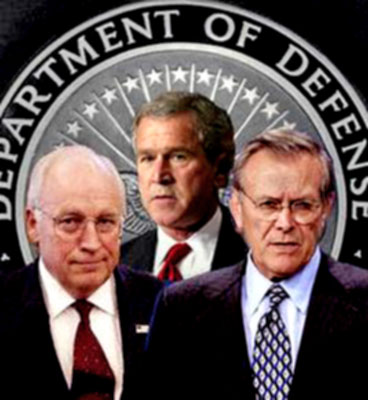
Meanwhile the workaholic had survived three heart attacks.
One of his first recommendations to Bush was the appointment of Rumsfeld,
almost 70, as secretary of defense. Deputy of his old associate became Paul Wolfowitz, a hardliner who had already worked for Cheney as chief strategist
in the Pentagon at the beginning of the 1990s.
Compared to these men
president Bush himself was a newcomer in Washington. Though he was blessed
with political instinct and a very practical intuition, he could hardly hold
a candle to these old hands intellectually.
One of the first steps of the new administration was the creation of a
“National Energy Policy Development Group”. It was headed directly by
Cheney.
Its final report, issued in May 2001, described the situation quite
openly:
“America in the year 2001 faces the most serious energy shortage since the
oil embargoes of the 1970s. (…) A fundamental imbalance between supply and
demand defines our nation's energy crisis. (…)
This imbalance, if allowed
to continue, will inevitably undermine our economy, our standard of living,
and our national security. (…)
Estimates indicate that over the next 20
years, U.S. oil consumption will increase by 33 percent, natural gas
consumption by well over 50 percent, and demand for electricity will rise
by 45 percent. If America's energy production grows at the same rate as it
did in the 1990s we will face an ever-increasing gap. (…)
By 2020, Gulf oil
producers are projected to supply between 54 and 67 percent of the world's
oil.
Thus, the global economy will almost certainly continue to depend on
the supply of oil from Organization of Petroleum Exporting Countries (OPEC)
members, particularly in the Gulf. This region will remain vital to U.S.
interests.” (22)
Later it was disclosed that Cheney's energy task force had also secretly
examined a map of the Iraqi oil fields, pipelines and refineries along with
charts detailing foreign suitors for ill-field contracts there.
Again, the
date was March 2001.
Anticipating the
unthinkable
Concurrently to its effort in energy policy the new administration created
an “Office of National Preparedness”.
It was tasked with the development of
plans responding to a possible terror attack and became assigned to the
“Federal Emergency Management Agency” (FEMA). (23)
FEMA was already
responsible for the COG plan since the 1980s.
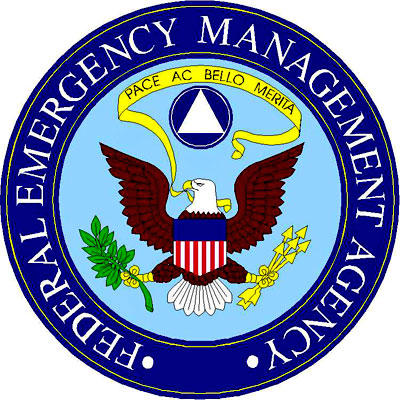
To call it back to mind:
“From
1982 to 1984, Oliver North assisted FEMA in revising contingency plans for
dealing with nuclear war, insurrection or massive military mobilization.”
(24)
Back then Cheney had played a role in shaping these plans.
Now he could
continue the work - because Bush appointed him to head the new program. (25)
Director of FEMA on the other hand became Joe Allbaugh, who had little
professional expertise, but could offer other qualities. Allbaugh was Bush's
campaign manager, a man for tough and rather rude matters and also one of
the president's closest confidants. Back in 1994 he had managed Bush's
campaign to become governor of Texas and at the end of 2000 he had helped
stopping the recount of votes in Florida. (26)
That an expert for political
tricks was appointed to head FEMA indicates that the administration had
political plans with the emergency management agency from the outset.
Till today it's undisclosed how the COG plan was refined in detail under
Cheney's direction in 2001. However the following is apparent: in the months
leading to 9/11 Cheney linked anti-terror and emergency management measures
with national energy policy.
Commissions working on both issues were handled
by him simultaneously. This connection anticipated the policy after 9/11,
which could be summarized as using a terror attack as rationale for
extending the power of the executive and waging war to seize control of
world regions important for energy supply.
The emergency plans Rumsfeld and Cheney were involved with since the 1980s
culminated in autumn 2001. On the morning of
September 11th the secret COG
program was implemented for the first time. (27)
Shortly before 10:00 a.m.,
after the impact of the third plane into the Pentagon, Cheney gave the order
to execute it. (28)
The shadow government
Almost nothing is known about the content of the plan and the specific
effects of its activation.
The secrecy in this respect appears grotesque.
Even the simple fact of the plan's implementation on 9/11 was concealed for
months. After sporadic hints in the press the Washington Post finally
disclosed some details in March 2002.
In an article titled “Shadow
government is at work in secret” it reported that about 100
high-ranking officials of different departments were working outside
Washington as part of the emergency plan since 9/11:
“Officials who are activated for what some of them call ‘bunker duty’ live
and work underground 24 hours a day, away from their families. As it settles
in for the long haul, the shadow government has sent home most of the first
wave of deployed personnel, replacing them most commonly at 90-day
intervals. (…)
Known internally as the COG, for ‘continuity of government’,
the administration-in-waiting is an unannounced complement to the
acknowledged absence of Vice President Cheney from Washington for much of
the past five months.
Cheney’s survival ensures constitutional succession,
one official said, but ‘he can't run the country by himself.’ With a core
group of federal managers alongside him, Cheney - or President Bush, if
available - has the means to give effect to his orders.” (29)
But what orders gave Cheney to his strange “shadow government” while his
stays at the bunker? And what justified extending this emergency measure for
seemingly infinite time?
For the White House clearly hadn't been wiped out
by bombs. The president lived and his administration was able to act. Who
needed a permanent second secret government?
After the first disclosure of these facts in spring 2002 leading politicians
of the legislative immediately started expressing their astonishment. Soon
it became clear that neither Senate nor House of Representatives knew
anything about the activation of COG and the work of the “shadow government”
in secret.
The parliament had simply been ignored. (30)
Later the 9/11
Commission experienced similar executive secrecy. Though it mentioned in its
final report the implementation of the plan on 9/11, it also admitted not
having investigated the issue in depth.
Instead the Commission had only been
briefed “on the general nature” of the plan. (31)
Patriots under
pressure
An immediate response to 9/11 was
the Patriot Act, passed only one month
later, and allowing a broad range of highly controversial measures, from
domestic wiretapping to warrantless detention of foreign terror suspects.
The latter legalized the forthcoming procedures at Guantánamo, leading to
secret U.S. prisons all over the world.
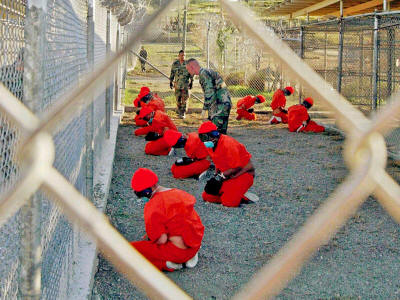
Two influential opponents of these legal changes were Tom Daschle, Senate
Majority Leader, and Patrick Leahy, head of the Senate Judiciary Committee.
Both received letters with spores of deadly anthrax. The source was never
traced with certainty. After that Daschle and Leahy gave up their resistance
against the new legislation and approved the Patriot Act. (32)
In their radical nature the hastily passed changes bore resemblance to
decrees while a state of emergency. And indeed were they similarly already
part of the COG plan in the 1980s. (33)
Government officials familiar with COG indicated after 9/11 that the plan
could really have resulted in martial law - if additionally to the attacks
on the World Trade Center and the Pentagon also large numbers of congressmen
and executive branch leaders had been killed on that day. (34)
Is it in this context a coincidence only that the fourth hijacked plane on
9/11 was heading towards Washington to hit the Capitol or the White House?
(35)
Killers from Sudan?
There is also circumstantial evidence for an assassination attempt on
president Bush in Florida that morning.
The Secret Service had received a
related warning the night before at 4:08 a.m., according to a TV report by a
local ABC affiliate. (36)
A few hours later Secret Service agents searched
an apartment in Sarasota and arrested four men from Sudan, apparently
belonging to the south sudanese liberation army
SPLA, a paramilitary force
secretly supported by the United States. (37)
Also AP reported these arrests
mentioning that the suspects had been released soon again because they had
“no connection” to 9/11. The whole issue just would have been a
“coincidence”. (38)
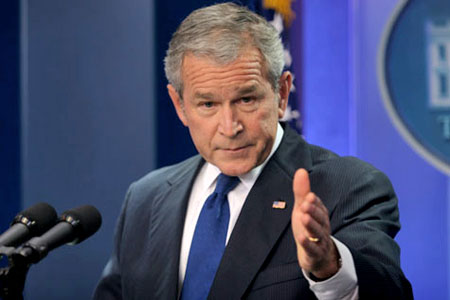
President
Bush spent the night before
9/11 at a resort on Longboat Key, an
island right next to Sarasota where he planned to visit an elementary school
on the next morning.
Longboat Key Fire Marshall Carroll Mooneyhan was a
further witness of the possible assassination attempt.
He said that at about
6 a.m. on September 11th a van with self-proclaimed reporters of middle
eastern descent had pulled up at Bush's resort, stating they had a
“poolside” interview with the president.
The men asked for a special Secret
Service agent by name but where turned away by the guards. (39)
Were these “reporters” identical with the Sudanese temporarily arrested by
the Secret Service later that morning in Sarasota? The incident resembled at
least the successful assassination of Taliban foe Ahmed Shah Massoud two
days before on September 9th in Afghanistan. The suicide attackers there
were also a fake TV team using a bomb hidden in a camera, as the New York
Times reported on September 10th. (40)
Additionally three witnesses remembered seeing Mohammed Atta and a companion
at Longboat Key's Holiday Inn on September 7th, three days before Bush would
spend the night on that same small island. (41)
September 7th was also the
day the White House first publicly announced Bush's schedule to travel to
Sarasota. (42) In this context it is surely worth to consider if Atta
scouted out the place for an assassination plot.
Completing the plot
The question arises:
Did a circle around Cheney, Rumsfeld and some
associates use 9/11 for a disguised coup d’état, partly failed in its
execution?
Regardless of the answer to that question - 9/11 in fact allowed the
implementation of emergency measures, the weakening of the legislative, the
start of several wars and a massive increase in defense spending.
The
amounts in question easily exceed the imagination of observers.
While in the second half of the 1990s the average national defense budget
totaled about 270 billion dollars a year, that number nearly doubled in the
decade after 9/11, when the average annual budget went up to over 500
billion. (43)
For the Pentagon's private contractors that meant a sales
increase of inconceivable 2.300 billion dollars between 2001 and 2010.
A national economy
under arms
If one looks at the development of defense spending in the United States
since 1940, some far-reaching conclusions arise. (44)
It seems as if the
attack on Pearl Harbor and the following involvement in World War II led to
a structural change of the American economy. The budgetary value of the
military was never reduced to a “normal” level after that. On the contrary
it increased decade by decade.
Thus the whole economy got into a fatal
dependency on the defense business.
This ongoing development came to a halt only with the fall of the Soviet
Union. Ten years later then 9/11 became the catalyzing event to kick-start
the military buildup again - with all its broad economic effects on the
country.
Cheney and Rumsfeld don't seem to be driving forces in this “game”, but
merely two talented managers, risen to the top in the stream of events.
Author James Mann, who had disclosed their involvement in the COG plan first
in 2004, described their political role this way:
“Their participation in the extra-constitutional continuity-of-government
exercises, remarkable in its own right, also demonstrates a broad,
underlying truth about these two men.
For three decades, from the Ford
Administration onward, even when they were out of the executive branch of
government, they were never far away. They stayed in touch with defense,
military, and intelligence officials, who regularly called upon them.
They
were, in a sense, a part of the permanent hidden national-security apparatus
of the United States, inhabitants of a world in which Presidents come and
go, but America keeps on fighting.” (45)
Notes
(1) US Department of Defense, 09.05.02,
“Secretary of Defense Donald H. Rumsfeld speaking at Tribute to
Milton Friedman”
(2) James Mann, “Rise of the Vulcans.
The History of Bush's War Cabinet”, New York 2004, p. 73
(3) Donald Rumsfeld, “Known and
Unknown. A Memoir”, New York 2011, p. 240
(4) Ibid., p. 245
(5) James Mann, “Rise of the Vulcans.
The History of Bush's War Cabinet”, New York 2004, pp. 138-145
(6) Ibid., p. 139
(7) Ibid., p. 138
(8) ABC, 25.04.04, “Worst Case Scenario
- Secret Plan to Control U.S. Government After an Attack Went Into
Motion on 9/11″
(9) James Mann, “Rise of the Vulcans.
The History of Bush's War Cabinet”, New York 2004, p. 140
(10) Ibid., p. 138; Washington Post, 07.04.04, “‘Armageddon’
Plan Was Put Into Action on 9/11, Clarke Says”, Howard Kurtz
(11) James Mann, “Rise of the Vulcans.
The History of Bush's War Cabinet”, New York 2004, p. 142
(12) Miami Herald, 05.07.87, “Reagan
Aides and the ‚secret‘ Government”, Alfonso Chardy
(13) Peter Dale Scott, “The Road to
9/11. Wealth, Empire, and the Future of America”, Berkeley 2007, p.
185; Executive Order 12656 - “Assignment of
emergency preparedness responsibilities”, 18.11.88
(14) Peter Dale Scott, “The Road to
9/11. Wealth, Empire, and the Future of America”, Berkeley 2007, p.
186
(15) Richard Clarke, “Against All
Enemies. Inside America's War on Terror”, New York 2004, p. 167
(16) PDD-NSC-67 - “Enduring
Constitutional Government and Continuity of Government Operations”,
21.10.98
(17) Project for the New American
Century, 03.06.97, “Statement of Principles”
(18) New York Times, 16.07.98, “Panel
Says U.S. Faces Risk Of a Surprise Missile Attack”, Eric Schmitt
(19) Project for the New American
Century, 26.01.98, “Iraq Clinton Letter”
(20) Project for the New American
Century, September 2000, “Rebuilding America's Defenses”, p. 51
(21) Barton Gellman, “Angler. The
Cheney Vice Presidency”, New York 2008, Chapter 1
(22) “National Energy Policy - Report
of the National Energy Policy Development Group”, 16.05.01
(23) White House press release,
08.05.01, “Cheney to Oversee Domestic Counterterrorism Efforts”
(24) Miami Herald, 05.07.87, “Reagan
Aides and the ‚secret‘ Government”, Alfonso Chardy
(25) White House press release,
08.05.01, “Cheney to Oversee Domestic Counterterrorism Efforts”
(26) Peter Dale Scott, “The Road to
9/11. Wealth, Empire, and the Future of America”, Berkeley 2007, p.
210
(27)
The 9-11 Commission Report, p. 38
(28) “Brief Timeline of Day of 9/11
Events, drafted by White House” Washington Post, 27.01.02, “America’s
Chaotic Road to War”, Dan Balz and Bob Woodward
(29) Washington Post, 01.03.02, “Shadow
Government Is at Work in Secret”, Barton Gellman and Susan Schmidt
(30) Washington Post, 02.03.02,
“Congress Not Advised Of Shadow Government”, Amy Goldstein and
Juliet Eilperin
(31)
The 9-11 Commission Report, p. 555
(32) Salon, 21.11.01, “Why Daschle and
Leahy?”, Anthony York
(33) Miami Herald, 05.07.87, “Reagan
Aides and the ‚secret‘ Government”, Alfonso Chardy
(34) ABC, 25.04.04, “Worst Case
Scenario - Secret Plan to Control U.S. Government After an Attack
Went Into Motion on 9/11″
(35)
The 9-11 Commission Report, p. 14
(36) Daniel Hopsicker, “Welcome to
Terrorland”, 2004, p. 42
(37) Ibid., p. 44
(38) Ibid., p. 45
(39) Longboat Observer, 26.09.01,
"Possible Longboat terrorist incident - Is it a clue or is it a
coincidence?“, Shay Sullivan
(40) New York Times, 10.09.01, "Taliban
Foe Hurt and Aide Killed by Bomb“
(41) Longboat Observer, 21.11.01,
"Two
hijackers on Longboat?“, Shay Sullivan
(42) White House, 07.09.01, "Press
Briefing by Ari Fleischer“
(43) US Office of Management and
Budget, “Table 3.1 - Outlays by Superfunction and Function:
1940–2016″
(44) Ibid.
(45) The Atlantic, March 2004, “The
Armageddon Plan”, James Mann











